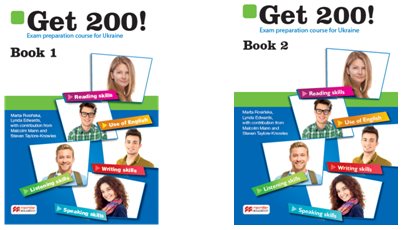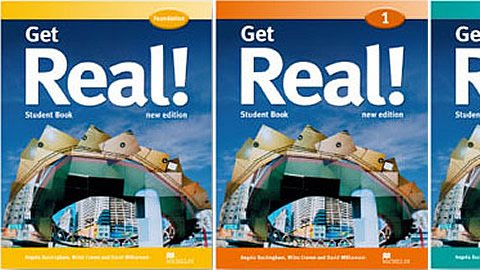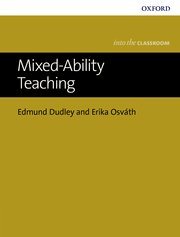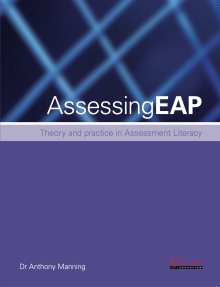Short Book Reviews
Hanna Kryszewska, Poland
Hanna Kryszewska is a teacher, teacher trainer, trainer of trainers. She is a senior lecturer at the University of Gdańsk, Poland. She is co-author of resource books: Learner Based Teaching, OUP, Towards Teaching, Heinemann, The Standby Book, CUP, Language Activities for Teenagers, CUP, The Company Words Keep, DELTA Publishing, and a course book series for secondary schools: ForMat, Macmillan. She is also co-author of a video based teacher training course: Observing English Lessons. Hania is a Pilgrims trainer and editor of HLT Magazine. E-mail: hania.kryszewska@pilgrims.co.uk

Get 200! Exam preparation course for Ukraine Book 1. Get 200! Exam preparation course for Ukraine Book 1. M. Rosińska, L. Edwards with contribution from M. Mann and S. Taylore-Knowles. Macmillan (2016). ISBN – 978-1-383-00337-0, pp 168, ISBN – 978-1-380-00339-3, pp 174. These two textbooks have been published specifically for the Ukrainian market. They prepare the learners for the state exam, and the course is fully compliant with government language programmes for students at levels 10-11 in the Ukrainian school system. The tasks in the textbook are at two levels, B1 and B2, providing a differentiated approach to students with different learning abilities and command of English. The units cover exam topic areas like: the human being, house and home, school, shopping, and Ukraine and the world. Each book contains ample exercises revising grammar, vocabulary and the four language skills, at the same time providing plenty of opportunity to perfect or master exam skills. The textbooks have been written for Macmillan Education in Ukraine by a team of leading authors from the publishing house. Some of the materials were based on the Polish publication Matura 2015 Repetytorium published by Macmillan Polska in 2014. The book is accompanied by an online exam companion.

Get Real! Foundation New edition (first published 2001). Get Real! 1 New edition (first published 2001). Get Real! 2 New edition (first published 2001). A. Buckingham, M. Craven and D. Williamson. ISBN 978-230-44716-5, pp. 94, ISBN 978-230-44708-0, pp. 94. ISBN 978-230-44710-3, pp. 94. This is a new edition of a 2001 English course which now has been specifically developed for learners of English in East Asia who are interested in learning American English rather than British English. It maintains many of the successful features of the earlier version of the course and also contains new features including modern design. The word ‘real’ used in the title is actually an acronym and here REAL stands for: realistic, easy to use, adaptable and lively. These four points summarise the nature of the course and characterise the approach of the authors. It is hard to say who the addressee of the book is. The levels range from A1 to A2+, which would suggest young learners in most countries of the world, but the artwork, photographs and drawings, which usually reflect the age of the learners, suggest a teenage or young adult audience.

Macmillan Science 1. Pupil’s Book (2011). Macmillan Science 1. Workbook (2011). Macmillan Science 6. Pupil’s Book (2011). Macmillan Science 6. Teacher’s book (2011). D. and P. Glover (student’s books and workbook - D. and P. Glover, teacher’s book P. Wadsworth. ISBN 978-0-230-73293-3, pp. 80, ISBN 978-0-230-02839-5, pp. 64, ISBN 978-0-230-73293-8, pp. 160, ISBN 978-0-230-02840-1, pp. 80 (respectively). This review looks at two titles which form a six level primary science course aimed at young learners of English as a foreign language. The course combines learning the language with science content (CLIL). The lessons are clearly structured, with clear language and content input. There are ideas for practical activities using everyday materials, many paper/pen exercises, topics for discussions and ideas for interactive learning in groups. The topics include among others: (Science 1) plants and their parts, seeds, animals, solids and liquids, (Science 6) human body, matter and materials, our earth, forces and energy. The books are richly illustrated with photos, diagrams, flow charts and other visual materials. The course book could be treated as the main resource used in class, or as dip-in material, if the learners are learning from a strictly ELT coursebook, without a pronounced CLIL component.

Secondary Science. C. Green. (2016). Independent Thinking Press. ISBN 978-178135241-0, pp. 214. This book was published in the How to Teach series. Other titles in the series include: Literacy, The Book of Plenary and Primary Maths. The book is aimed at science teachers but it will be of great interest to ELT teachers or teachers who deliver CLIL courses in English. The book takes a fresh look at teaching science; as the author says no ‘white coats, or slides’ or being stuck in the rut with the teaching methods and activities. The author has a long teaching experience which she generously shares with other teachers in her book. Her aim is to develop activities which are memorable, fun, make efficient use of the time, and, above all, enable learning. She shows how to use thought provoking stories, how to give meaningful explanations, how to make input memorable and make it stick, how to make input for individual sessions relate to content from other sessions (what the author calls ‘joining-up the science curriculum), how to teach so called difficult topics, and finally gives a guide to practical work. Personally, I don’t do science in English classes, but when I showed this book to teachers who do, they were very very impressed and inspired.

Mixed-Ability Teaching. E. Dudley and E. Osváth (2015) OUP. ISBN 978-0-19-420038-7, pp 112. This book is another title in the new OUP series: Into The Classroom, which is different from the old well established OUP series: Resource books for teachers. The books in this new series are short and practical guides aimed at teachers of primary and secondary school learners. The books help the teachers to explore new teaching tools and techniques, or to become familiar with new educational policies and ways of implementing them in the classroom. The title in question focuses on how to work with mixed ability classes, and calls for collaborative ways of teaching and learning, creating a positive classroom atmosphere which takes into account every student with their strengths and weaknesses, and creating support and challenge for every student. Every teacher can relate to the issue of mixed-ability, mixed performance and mixed level classes. Even more so with inclusive teaching being increasingly more widespread in our classrooms and teaching environments. The book looks at the features of mixed-ability classes, offers activities that address mixed ability, promotes learner centered teaching and assessment, and, finally, gives ideas on how open-endedness in language activities helps. The sections in the book look at preparing for teaching mixed-ability classes, managing the classroom, making the most of the time and resources, collaborating, assessing and understanding the learners. Highly recommended.

Assessing EAP. Theory and practice in Assessment Literacy. A. Manning. Garnet Education. (2016) ISBN 978-1-78260-226-2, pp.200. Teaching EAP is not easy… and assessing is even more difficult. This book gives tools to design, interpret tests and shows how to fit the results into global assessment. It takes into account different teaching contexts and different groups of learners. The 15 chapters in the book look at different aspects of assessment combining research and classroom practice. The topics, among others, include: aims of assessment, test validity, criteria to consider when designing tests, awareness of problems when designing tests and interpreting the results, marking and grading, selecting texts and tasks for tests, statistics and maths in interpreting test results, washback, and ethics. The book also contains an exhaustive and comprehensive glossary of the terms used in the book and their definitions.

Please check the Methodology & Language for Primary course at Pilgrims website.
Please check the Methodology & Language for Secondary course at Pilgrims website.
Please check the Methodology & Language for Advanced course at Pilgrims website.
Please check the CLIL for Primary cours at Pilgrims website.
Please check the CLIL for Secondary course at Pilgrims website.
Please check the How to be a Teacher Trainer course at Pilgrims website.


|